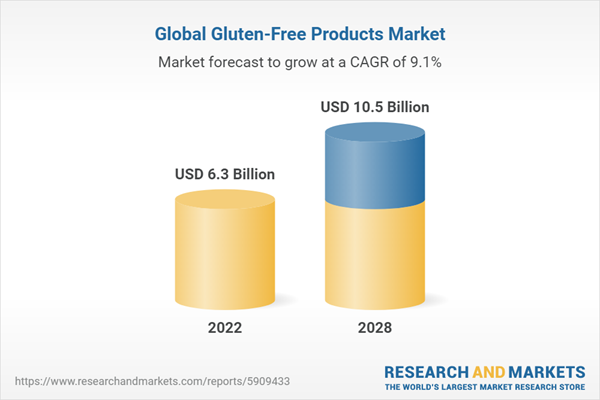Free Webex Call
The Global Gluten-Free Products Market reached a valuation of USD 6.30 billion in 2022 and is expected to experience robust growth during the forecast period, with a projected Compound Annual Growth Rate (CAGR) of 9.1% through 2028. This market segment has emerged as a dynamic and rapidly expanding sector within the broader food industry. Speak directly to the analyst to clarify any post sales queries you may have.
10% Free customizationThis report comes with 10% free customization, enabling you to add data that meets your specific business needs.
One of the primary driving forces behind the growth of the gluten-free products market is the increasing awareness of celiac disease, an autoimmune disorder triggered by gluten consumption. Additionally, a growing number of individuals without celiac disease are choosing gluten-free diets for perceived health benefits, including improved digestive comfort, weight management, and increased energy levels.
The gluten-free products market encompasses a wide range of offerings, including bakery goods, pasta, snacks, cereals, and even beverages. As consumers become more discerning about their dietary preferences, the market has responded with an expanding range of innovative and flavorful gluten-free alternatives that closely mimic the taste and texture of traditional gluten-containing foods.
The global trend towards healthier eating has significantly influenced the gluten-free products market. Consumers increasingly associate gluten-free options with healthier choices, leading manufacturers to formulate products with wholesome ingredients, reduced sugar content, and enhanced nutritional value.
However, the gluten-free products market faces challenges. Creating gluten-free products that deliver on taste, texture, and nutritional value can be complex. Ingredients that replicate gluten's functionality are often required, necessitating innovative formulations and production processes.
As consumers become more conscious of their food choices, they demand clear and accurate labeling of gluten-free products. Regulatory standards for gluten-free claims vary across countries, requiring manufacturers to adhere to stringent guidelines to ensure transparency and credibility.
The demand for gluten-free products is not limited to a single region; it spans the globe. Therefore, manufacturers must balance the need for standardized quality while accommodating regional tastes and preferences.
The gluten-free products market continues to evolve through ongoing research and technological advancements. Manufacturers are investing in developing novel ingredients and production methods to enhance the taste, texture, and nutritional profile of gluten-free offerings.
Key Market Drivers:
1. Health and Wellness Trends: Growing emphasis on health and wellness is a primary driver of the increased demand for gluten-free products. Consumers adopt gluten-free diets to address health concerns, including celiac disease, gluten sensitivity, weight management, and digestive health.2. Changing Lifestyles and Dietary Preferences: Modern lifestyles characterized by convenience-seeking behaviors have led to a rising demand for ready-to-eat and on-the-go gluten-free food options. The market has witnessed the emergence of gluten-free snacks, frozen meals, and pre-packaged baked goods.
3. Product Innovation and Availability: Innovation is key in the gluten-free products market. Manufacturers have invested in research and development to create gluten-free products that closely mimic the taste and texture of traditional foods. This diversification has expanded the consumer base.
Key Market Challenges:
1. Maintaining Quality and Taste: Formulating gluten-free products that match the taste and texture of traditional gluten-containing foods is challenging. Alternative flours can result in denser or crumbly products, requiring innovative solutions to improve texture and palatability.2. Ensuring Nutritional Adequacy: Many gluten-free products may lack essential nutrients naturally present in whole grains. Manufacturers must address this by fortifying products with necessary nutrients and providing clear nutritional information.
3. Meeting Labeling and Certification Standards: Accurate and transparent labeling is crucial, but maintaining a gluten-free status requires strict manufacturing processes to prevent cross-contamination, which can be challenging for some manufacturers.
Key Market Trends:
1. Growing Health and Wellness Consciousness: Increased health consciousness among consumers has led to the perception that gluten-free products are healthier options. This trend is driven by awareness of gluten-related health issues.2. Innovation and Diversification: The market has evolved to offer a wide range of gluten-free products, from baked goods to pasta, with an emphasis on clean ingredient labels and natural and organic ingredients.
3. E-Commerce and Direct-to-Consumer Channels: Online sales have significantly impacted the market by providing convenience, variety, transparency, and engagement opportunities. Online platforms have become crucial in reaching consumers seeking gluten-free products.
Regional Insights:
North America: North America dominates the gluten-free products market due to factors such as rising awareness of gluten-related disorders, health-conscious consumer preferences, advanced food industry infrastructure, and stringent labeling standards. The region's focus on research and innovation has resulted in high-quality gluten-free offerings. Marketing and labeling transparency have further boosted the market's expansion in North America.Report Scope:
In this report, the global gluten-free products market has been segmented into the following categories, in addition to the industry trends which have also been detailed below:Gluten-Free Products Market, By Type:
- Bakery Products
- Pizzas & Pastas
- Cereals & Snacks
- Savories
- Others
Gluten-Free Products Market, By Source:
- Oilseeds & Pulses
- Rice & Corn
- Dairy & Meat Products
- Others
Gluten-Free Products Market, By Sales Channel:
- Supermarkets/Hypermarkets
- Convenience Stores
- Online
- Others
Gluten-Free Products Market, By Region:
- North America
- United States
- Canada
- Mexico
- Asia-Pacific
- China
- India
- Japan
- South Korea
- Australia
- Europe
- Germany
- France
- United Kingdom
- Italy
- Spain
- South America
- Brazil
- Argentina
- Colombia
- Middle East & Africa
- Saudi Arabia
- UAE
- South Africa
- Turkey
Competitive Landscape
Company Profiles: Detailed analysis of the major companies present in the global gluten-free products market.Available Customizations:
Global Gluten-Free Products Market report with the given market data, the publisher offers customizations according to a company's specific needs.This product will be delivered within 1-3 business days.
Table of Contents
1. Introduction
2. Research Methodology
3. Executive Summary
4. Voice of Customer Analysis
5. Global Gluten-Free Products Market Outlook
6. North America Gluten-Free Products Market Outlook
7. Europe Gluten-Free Products Market Outlook
8. Asia-Pacific Gluten-Free Products Market Outlook
9. Middle East & Africa Gluten-Free Products Market Outlook
10. South America Gluten-Free Products Market Outlook
11. Market Dynamics
12. Impact of COVID-19 on Global Gluten-Free Products Market
14. Porter’s Five Forces Model
15. SWOT Analysis
16. Competitive Landscape
17. Strategic Recommendations/Action Plan
Companies Mentioned
- Conagra Brands, Inc.
- The Hain Celestial Group
- General Mills Inc.
- Kellogg Co.
- The Kraft Heinz Company
- Hero Group
- Barilla G. e R. Fratelli S.p.A
- Seitz glutenfrei
- Freedom Foods Group Limited
- Ecotone
Table Information
| Report Attribute | Details |
|---|---|
| No. of Pages | 190 |
| Published | November 2023 |
| Forecast Period | 2022 - 2028 |
| Estimated Market Value ( USD | $ 6.3 Billion |
| Forecasted Market Value ( USD | $ 10.5 Billion |
| Compound Annual Growth Rate | 9.1% |
| Regions Covered | Global |
| No. of Companies Mentioned | 10 |









